
Begonia is a genus of perennial flowering plants in the family Begoniaceae. The genus contains more than 2,000 different plant species. The Begonias are native to moist subtropical and tropical climates. Some species are commonly grown indoors as ornamental houseplants in cooler climates. In cooler climates some species are cultivated outside in summertime for their bright colorful flowers, which have sepals but no petals.

Assam tea is a black tea named after Assam, India, the region of its production. It is manufactured specifically from the plant Camellia sinensis var. assamica (Masters). Assam's people tried to plant the Chinese varieties in Assam soil but did not succeed. Assam tea is now mostly grown at or near sea level and is known for its body, briskness, malty flavour, and strong, bright colour. Assam teas, or blends containing Assam tea, are often sold as "breakfast" teas. For instance, Irish breakfast tea, a maltier and stronger breakfast tea, consists of small-sized Assam tea leaves.

Begonia grandis, the hardy begonia, is a species of flowering plant in the family Begoniaceae. This herbaceous perennial has alternate, simple leaves on arching stems. The flowers are pink or white, borne in dichotomously branching cymes from late summer through fall in USDA U.S. Hardiness Zone 7. As the common name "hardy begonia" implies, it is winter hardy in some temperate regions.
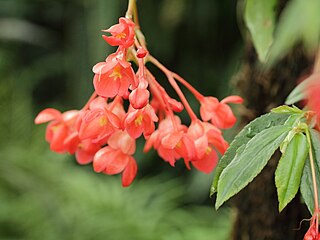
Begonia foliosa is a species of flowering plant in the family Begoniaceae, native to Colombia and Venezuela. It is a shrublike begonia growing to 1 metre (3.3 ft), bearing succulent, pendent stems 45 centimetres (18 in) long, thickly clothed with glossy oval green leaves, and producing panicles of small white flowers. The variety commonly cultivated is B. foliosa var. miniata with pink or red flowers. As it does not tolerate temperatures below 0 °C (32 °F), in temperate regions it requires winter protection.

Pteris cretica, the Cretan brake, ribbon fern, or Cretan brake fern, is a species of evergreen fern in the family Pteridaceae, native to Europe, Asia and Africa.

Clintonia udensis is a species of flowering plant in the lily family Liliaceae. It is the only species of Clintonia native to Asia. It prefers sparsely forested habitat including the alpine forests of the Himalayas.

Begonia aconitifolia is a species of plant in the family Begoniaceae, endemic to Brazil. It grows up to 1 meter in height, with panicles of pink flowers.

Begonia cucullata, also known as clubbed begonia, is a species of the Begoniaceae that is native to South American countries of Argentina, Brazil, Paraguay, and Uruguay. A common garden plant and part of the section Begonia, it was described in 1805 by Carl Ludwig Willdenow (1765–1812). The specific epithet "cucullata" means "resembling a hood" or "hooded".

Begonia annulata, the ringed begonia, is a species of flowering plant in the genus Begonia native to the eastern Himalaya, Bangladesh, Assam in India, Myanmar, and Vietnam. It has gained the Royal Horticultural Society's Award of Garden Merit.

Begonia dregei, the maple leaf begonia or grape-leaf begonia, is a species of flowering plant in the genus Begonia native to the Eastern Cape and KwaZulu-Natal provinces of South Africa. It has gained the Royal Horticultural Society's Award of Garden Merit.
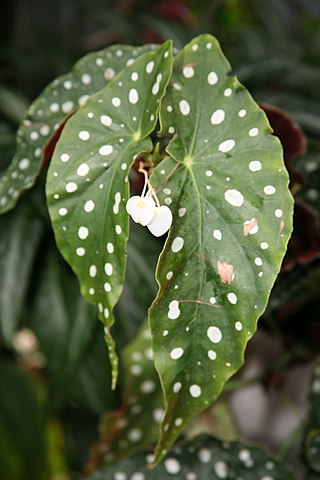
Begonia maculata, the polka dot begonia, is a species of begonia native to southeast Brazil. It grows naturally in the Atlantic rainforest, with occurrences confirmed in the Brazilian states of Espírito Santo and Rio de Janeiro. It has been introduced into Mexico, Cuba, the Dominican Republic, and Argentina.

Begonia rex, the king begonia, is a species of flowering plant in the family Begoniaceae. It is found from Arunachal Pradesh to southeast China, and has been introduced to Bangladesh, Cuba, and Hispaniola. It is a parent to over 500 cultivars in the Begonia Rex Cultorum Group of houseplants. Other parents in the multitude of crosses made during the creation of the Group include Begonia annulata, B. cathayana, B. decora, B. diadema, B. dregei, B. grandis, B. hatacoa, B. palmata, and B. xanthina.
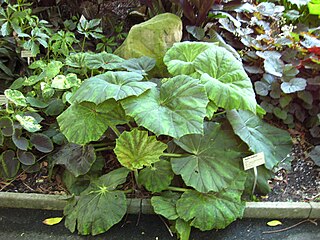
Begonia megaptera, the large winged begonia, is a species of flowering plant in the family Begoniaceae, native to Nepal, the eastern Himalaya, Assam, Bangladesh, and Myanmar. Very rare in its native habitat, it is cultivated as an ornamental and medicinal plant.
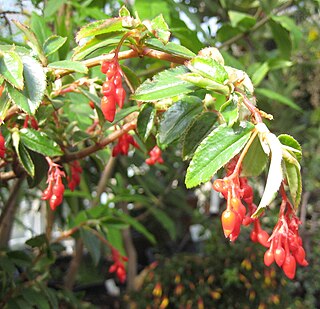
Begonia fuchsioides, the fuchsia begonia, is a species of flowering plant in the family Begoniaceae. It is native to Ecuador, Colombia, and western Venezuela, and has been introduced to Hawaii and Réunion. A small bush reaching 2 ft (60 cm), it is hardy to USDA zone 10a.
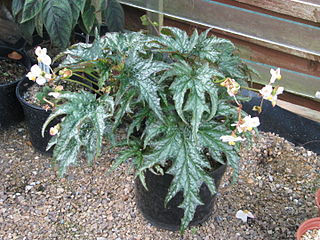
Begonia sikkimensis is a species of flowering plant in the family Begoniaceae, native to Tibet, Nepal, the eastern Himalayas, Assam, and Myanmar. With its highly dissected leaves it resembles Begonia U614, but that as yet undescribed species is rhizomatous, and Begonia sikkimensis is caulescent.

Dipankar Borah is an Indian field botanist from Assam.

Begonia hispida, the piggyback begonia, is a species of flowering plant in the family Begoniaceae, native to southeastern and southern Brazil. They are occasionally cultivated due to their "piggyback" leaflets which grow directly from veins in the main leaves. The piggyback mutation is also seen in Arabidopsis.

Begonia xanthina is a species of flowering plant in the family Begoniaceae, native to the eastern Himalayas, Assam, and southwestern Yunnan in China. A rhizomatous geophyte reaching 40 cm (16 in), it is typically found growing near streams on rocky forested hills up to 800 m (2,600 ft) in elevation. It resembles Begonia rex, but with yellow flowers and scattered light green splotches on the leaves.


















